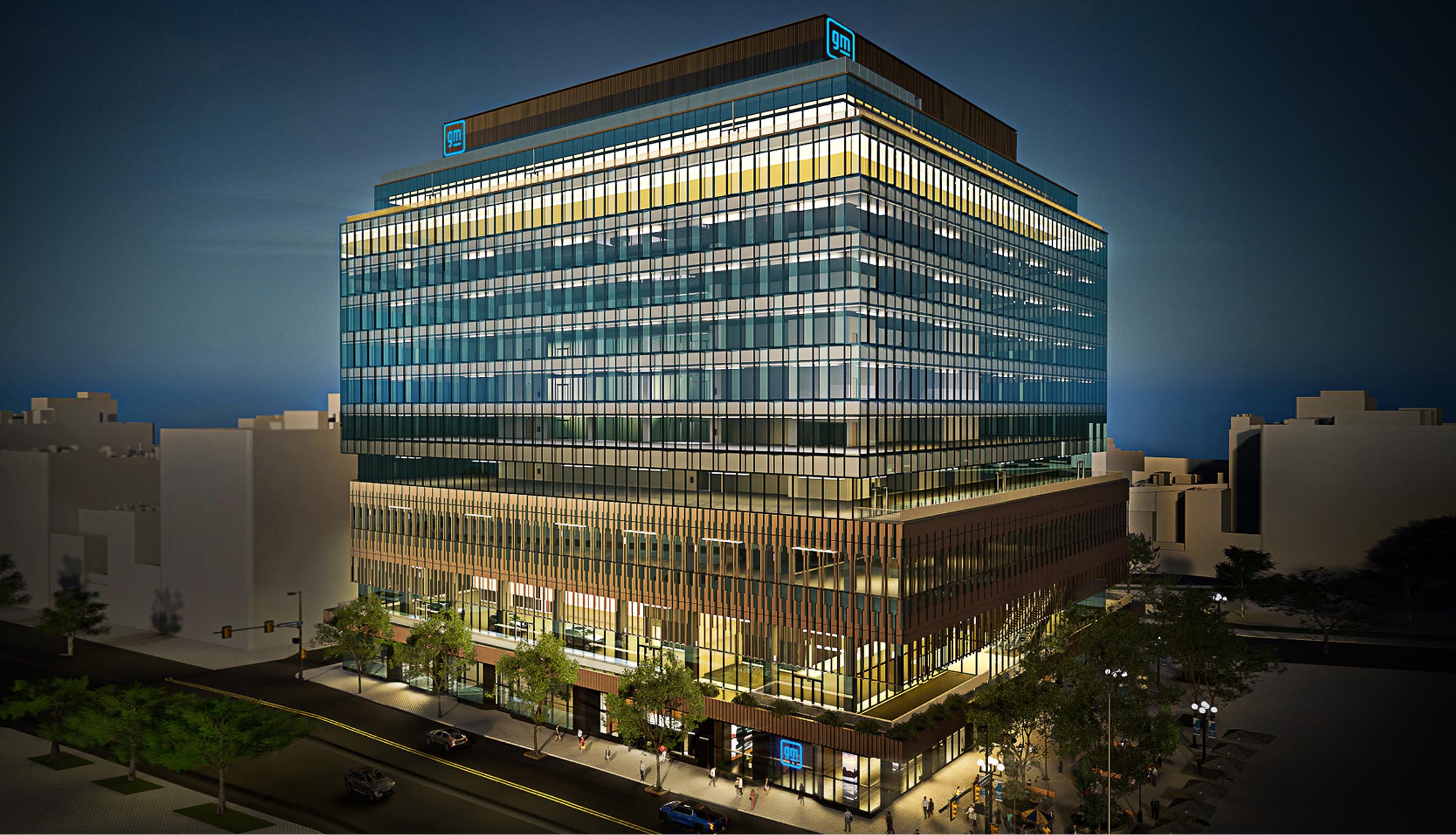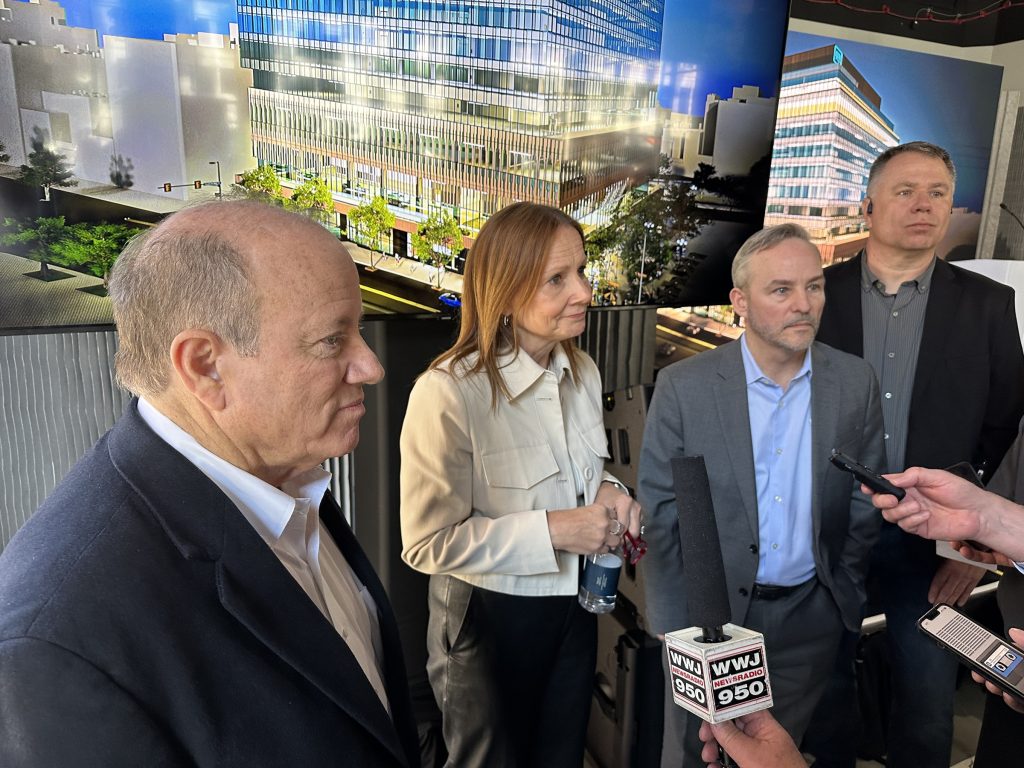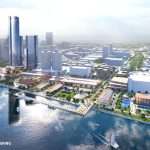For the fourth time in its more than 100-year history, General Motors is moving its corporate headquarters – but it isn’t going very far. The automaker will relocate from the current, facility along the Detroit River to the city’s newest highrise 1.2 miles away. The move was driven by a variety of factors, said GM CEO Mary Barra, including the need for less office space following the COVID pandemic.
In a surprise move, General Motors announced Monday that it will walk away from Detroit’s towering Renaissance Center complex which had served as its corporate headquarters since 1996. The automaker will soon relocate to the smaller of two new office buildings nearing completion in the Motor City’s central business district.
“GM will continue to call Detroit its home for a long time to come,” said CEO Mary Barra during a presentation Monday afternoon at the still-unfinished building. When completed, she said, it “will be our corporate headquarter, a nerve center and a collaborative space for our employees.”
During the initial presentation and subsequent conversations with reporters, GM officials left a number of questions unanswered, starting with the cost of the move. And Barra said the automaker has just launched a study to see what can be done with the soon-to-be-vacant RenCen. Detroit Mayor Mike Duggan said the city and county will work with GM to find a solution, along with Bedrock, the company building the new GM headquarters.
A controversial history
Built a half-century ago as one of the biggest urban renewal projects in Detroit history, the RenCen, as it is known locally, has had a controversial history. It originally was a pet project of Henry Ford II, the former Ford Motor Co. Chairman and CEO. Following his death, Ford moved many of the operations based there back to its own headquarters in the Detroit suburb of Dearborn.
It was significantly underutilized when GM purchased the facility in 1996, moving out of a 1920s-era building several miles to the north. But the new owners quickly realized the fire sale purchase price was just the beginning of what they’d need to invest. Among other things, the RenCen’s convoluted design has long frustrated those who work there, even after GM invested more than $1 billion to address the building’s shortfalls.
But the biggest problem, said several GM executives, is that the working environment has changed over the past three decades. Not only has the automaker downsized at a corporate level but it has streamlined its workforce and distributed many employees to other nearby facilities, such as its Technical Center in the suburb of Warren.
More GM News
- GM Takes Another Step Towards Going Back to the Moon
- Chevy Finally Launching Retail Sales of Silverado EV
- GM, Honda Begin Joint Production of Fuel Cells
Relocating the workforce
One of the questions GM wasn’t ready to answer Monday was how many of its employees would work at the new headquarters building. At peak, before the automaker’s 2009 bankruptcy, at least 10,000 employees and contract staff reported in at the RenCen — which consisted of a 73-story main tower and four shorter towers. GM will take only two of a dozen stories in its new headquarters building, though it may later add more space, among other things, for a corporate vehicle showroom.
“That will fluctuate quite a bit,” said the automaker’s President Mark Reuss, and for a variety of reasons.
Coming out of Chapter 11 the automaker dropped several brands, Pontiac, Saturn, Hummer, and Saab. It subsequently shuttered operations in Europe, Russia, India, and Australia, among other money-losing markets. Then COVID hit. GM initially switched to a work-at-home model. It has since adopted what Reuss called a “hybrid” model, most employees reporting in several days a week – though not necessarily at the same time.
Some key headquarters operations will base at the new facility, notably C-Suite offices, legal, and communications. Adding to the uncertainty, however, some employees now at the RenCen may move to suburban offices while others currently based at those satellites could be moved back to Detroit, Barra and Reuss both noted.
What to do with the RenCen
The biggest question is what now happens to the RenCen. As the tallest and most iconic building on the Detroit skyline all those involved in the GM move say they plan to find a way to not only reuse the skyscraper but increase its occupancy.
Barra said the automaker has launched a year-long study exploring “all possible options.”
That, according to Detroit Mayor Duggan, could include mixed-use applications ranging from office and hotel space to retail and even residential. After decades of decline, the city is finally beginning to see growing demand for housing, especially in and around the downtown and midtown neighborhoods.
One of the challenges, said a GM insider asking not to be identified, is that “it would be extremely expensive” to retrofit a highrise designed for offices to handle a large number of housing units.
Duggan said he is hopeful new commercial businesses will see an opportunity to move into the complex – which offers expansive views of not only Detroit and the Detroit River but the Canadian city of Windsor which, in a curious quirk of geography, lies to the south of the Motor City.
“I’m totally open-minded” when it comes to future uses for the RenCen, said Duggan. “We’re 48 hours into this. “You’ve got to give us” time to figure this out.











0 Comments